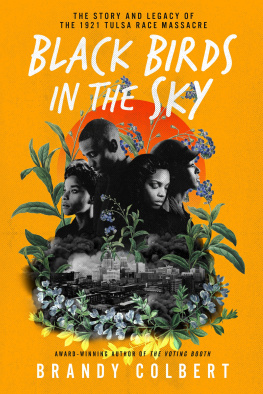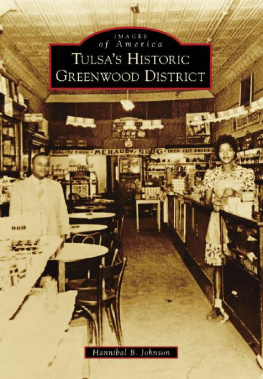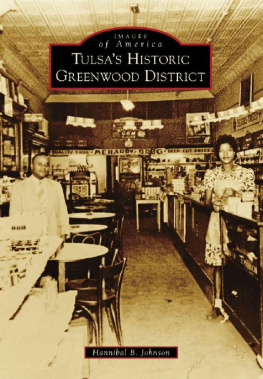1. The Tulsa Massacre and Its Context
Introduction
James West was attending a play when a youth rushed in and delivered the warning that a resident of Tulsa, Oklahomas black district, might be lynched. West, a teacher and fellow resident of the district known as Greenwood, hurried home and awaited further development. Later that evening and into the early morning hours, West lay awake as the sound of gunfire erupted throughout his district. Shortly after 5:30 a.m., white men arrived at his home and ordered him outside. West was placed with a larger group and was violently escorted to Tulsas Convention Hall. Around the same time, Carrie Kinlaw and her sisters emerged from their Greenwood home after growing increasingly concerned about the safety of their mother, who lived a few blocks away. Upon arriving, they placed their mother on a cot and carried her while bullets flew all around. Eventually, gangs of rioters from all ages surrounded them, and they watched helplessly as nearby homes were broken into, looted, and destroyed (Parrish , pp. 37, 50).
The Tulsa Race Massacre of 1921 took place on May 31 and June 1 and occasioned one of the most destructive and lethal acts of collective violence in American history. Thirty-five city blocks of homes, businesses, and churches that encompassed the comparably affluent black community of Greenwood were reduced to rubble by white citizens and officials committed to projecting and maintaining a dominant position in local society. Scores of lives were taken during the massacre, which occurred after armed black residents appeared at the local courthouse to prevent the lynching of a Greenwood resident wrongfully accused of assaulting a white woman. While many local whites and city leaders immediately rationalized the violence as a justified response to a Negro Uprising, historical documentationalong with a burgeoning public interesthas led to the events of 1921 being understood not as an act of insurrection, but a racially charged massacre (e.g., Krehbiel ). The destruction of Greenwood was only one of several similar massacres throughout America during the early part of the twentieth century.
What were the forces that caused the Tulsa Race Massacre of 1921? What factors help explain why various groups, provided with the same objective facts related to the event, have made diametrically opposed judgments about culpability? What processes explain how and why some historical events such as the Tulsa Race Massacre experience re-branding, wherein once-deemed perpetrators of the riot are overwhelmingly cast as victims? In such cases, what constraints prevent full atonement, reconciliation, and reparation? Finally, as the Tulsa Massacre has approached its centennial year, what is its legacy? What lessons were learned and, perhaps most importantly, what remains unresolved?
This book examines the Tulsa Race Massacre in order to advance a holistic approach for studying forms of collective violence , such as riots. It is argued that collective violence can be more systematically understood through analyzing three key features: (1) the underlying social forces, or causative factors; (2) the events and processes which transpire during collective violence; and (3) the framing of collective violencehow the events are interpreted and portrayed in ways designed to resonate with others. Additionally, the chapter explores how such events can subsequently be re-framed in ways that supplant preexistent narratives and understandings. Each of these features is interconnected and socially constructed and may allow for a more complete and nuanced grasp not only of the Tulsa Massacre and its aftermath, but also of contemporary forms of collective violence as well. To this purpose, this chapter takes a deeper look at the massacre and the broader historical context in which it was situated.
Precipitating Events
On May 31, the
Tulsa Tribune ran an inflammatory article, Nab Negro for Attacking Girl in an Elevator, which detailed, with great exaggeration and a fudging of facts, an alleged attack by a black resident, Dick Rowland , against a white college student, Sarah Page. The article stated:
A negro delivery boy who gave his name to the public as Diamond Dick but who has been identified as Dick Rowland, was arrested on South Greenwood avenue this morning by Officers Carmichael and Pack, charged with attempting to assault the 17-year-old white elevator girl in the Drexel building early yesterday. He will be tried in municipal court this afternoon on a state charge. The girl said she noticed the negro a few minutes before the attempted assault looking up and down the hallway on the third floor of the Drexel building as if to see if there was anyone in sight but thought nothing of it at the time. A few minutes later he entered the elevator she claimed, and attacked her, scratching her hands and face and tearing her clothes. Her screams brought a clerk from Renbergs store to her assistance and the negro fled. He was captured and identified this morning both by the girl and clerk, police say. Rowland denied that he tried to harm the girl, but admitted he put his hand on her arm in the elevator when she was alone. Tenants of the Drexel building said the girl is an orphan who works as an elevator operator to pay her way through business college. (Nab Negro , p. 1)













